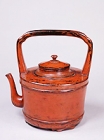Japanese Gallery (Honkan) Room 13
June 12, 2007 (Tue) - September 17, 2007 (Mon)
Many of the furnishings and utensils used at temples and shrines during the medieval period were coated with red lacquer. Today, such old objects with red lacquer are called negoro-nuri. Red lacquered utensils were already in use during the Heian period (794-1192). However, it is thought that during the Kamakura period (1192-1333), the priests who had moved from temples on Mt. Koya to Negoroji temple in Kii province started producing these utensils for use at Negoroji. The red-lacquered utensils produced at Negoroji came to be called negoro-nuri; and as use of the name spread, all red lacquered items came to be called negoro-nuri.
Most negoro-nuri consists of coatings of black lacquer covered with coatings of red lacquer. After the wear-and-tear of many years of use, the red lacquer is worn away, exposing the black lacquer coating underneath in various places. The lacquer coating degrades, which causes fine cracks to appear and gives the surface a unique weathered appearance that cannot be replicated since negoro-nuri utensils had many practical uses, their simple and efficient shape also has a modern and sharp sense.

